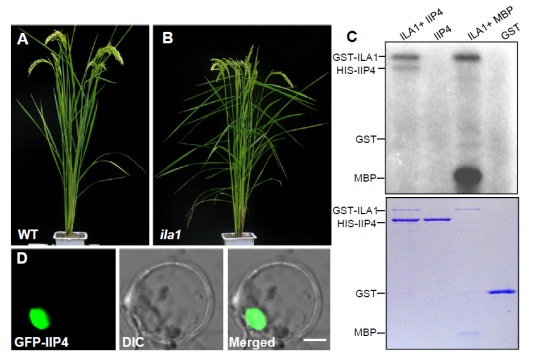Plant cell wall comprised of a complex polysaccharidic network often provides mechanical support for plant bodies. Studies on cell wall formation would benefit to the breeding for lodging resistant and agronomic trait improved varieties. Erect leaf is an eminent trait for rice, which facilitates enhancing photosynthetic efficiency and dense planting. Most of the identified rice leaf inclination mutants have arisen from BR (brassinosteroid)-related abnormal division and expansion of adaxial cells. However, regulation of leaf angles through control of cell-wall formation has not been described previously.
A rice mutant with increased leaf angles (ila1) has been characterized by researchers in Dr. Lizhong Xiong’s group, Huazhong Agricultural University and Dr. Yihua Zhou’s group, Institute of Genetics and Developmental Biology, Chinese Academy of Sciences. Genetic analysis showed that the phenotypes of ila1 mutant result from a T-DNA insertion in a Group C MAPKKK gene. The increased leaf angle in ila1 is caused by abnormal vascular bundle formation and wall composition in the lamina joints, as distinct from the mechanism observed in BR-related mutants. ILA1 is predominantly resident in the nucleus and expressed in the vascular bundles of leaf lamina joints. Six closely related ILA1 interacting proteins (IIPs) of unknown function were identified by yeast two-hybrid screening, and the interaction was confirmed in vivo with representative IIPs. IIPs were nucleus-localized and showed transactivation activity. Furthermore, phosphorylation assays revealed that ILA1 possesses Ser/Thr kinase activity and phosphorylates IIP4, indicating that IIPs may be the down-stream substrates of ILA1. Microarray analyses of lamina joints provided additional evidence for alterations in mechanical strength in ila1. ILA1 is thus a key factor regulating mechanical tissue formation at the leaf lamina joint.
This work has been online published on The Plant Cell (DOI:10.1105/tpc.111.093419). Jing Ning in Dr. Lizhong Xiong’s group, Huazhong Agricultural University and Baocai Zhang in Dr. Yihua Zhou’s lab, Institute of Genetics and Developmental Biology, Chinese Academy of Sciences, contribute equally as the first authors. This work is a collaborative research project between the two groups and funded by National Natural Science Foundation of China and the National Program on High Technology Development.
AUTHOR CONTACT:
Yihua Zhou, Ph.D.
Institute of Genetics and Developmental Biology, Chinese Academy of Sciences, Beijing, China.
E-mail: yhzhou@genetics.ac.cn

(Image by Ning Jing etc.)
Figure.ILA1 regulates rice leaf angles and phosphates IIP4. (A, B) Leave of ila1 plants have larger inclination angle (B) than those of wild type (A).(C) ILA1 phosphates IIP4. Purified recombinant GST-ILA and HIS-IIP4 were incubated with radiolabeled ATP, separated on the SDS-PAGE, and subjected to autoradiography (upper panel) or stained with Coomassie blue (lower panel). (D) GFP-IIP4 is localized in the nucleus. Rice protoplast cells expressing GFP-IIP4 were observed under the confocal microscope after overnight incubation.



